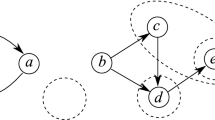Abstract
In this paper we investigate the logics obtained by augmenting first-order logic (with successor) with operators corresponding to some decision problems complete forNP via logspace reductions. We show that our encodings of the Satisfiability Problem and the 3-Colourability Problem, namely SAT and 3COL, respectively (as sets of finite structures over specific vocabularies), are complete forNP via projection translations (very weak reductions between problems): the fact that an encoding of the Satisfiability Problem (resp. the 3-Satisfiability Problem) is (resp. not) complete forNP via interpretative reductions (again, very weak reductions) had been shown previously by Dahlhaus. It is unknown whether our encoding of the 3-Satisfiability Problem, namely 3SAT, is complete forNP via projection translations, although we show that it is for iterated projection translations. However, if we consider an encoding of the version of the 3-Satisfiability Problem where each instance has at most three literals in each clause (as opposed to exactly three literals), namely ≤ 3SAT, then we show that ≤3SAT is complete forNP via projection translations. It appears to matter as to how we encode a decision problem as a set of finite structures over some vocabulary when considering weak reductions such as ours. Our proof that SAT is complete forNP via projection translations differs extremely from the proof of Dahlhaus that SAT is complete forNP via interpretative reductions, as he relies on Fagin's well-known characterization ofNP whereas our results do not: indeed, they give Fagin's result as a corollary. We use the problem 3COL to show the difference between interpretative reductions and projection translations as we show that 3COL is complete forNP via the latter but not via the former. The logics mentioned above are shown to be similar in expressibility but are shown to be much more expressible than that formed by extending first-order logic with an operator corresponding to the Hamiltonian path problem for digraphs (assumingNP ≠co-NP).
Similar content being viewed by others
References
C. C. Chang and H. J. Keisler,Model Theory, North-Holland, Amsterdam, 1977.
E. Dahlhaus, Reduction to NP-complete problems by interpretations,Logic and Machines: Decision Problems and Complexity (ed. Borger, Rödding, Hasenjaeger), Lecture Notes in Computer Science, Vol. 171, Springer-Verlag, Berlin, 1984, pp. 357–365.
R. Fagin, Generalized first-order spectra and polynomial-time recognizable sets,Complexity of Computation (ed. R. Karp), SIAM-AMS Proceedings, Vol. 7, 1974, pp. 27–41.
M. R. Garey and D. S. Johnson,Computers and Intractability, Freeman, San Francisco, 1979.
Y. Gurevich, Toward logic tailored for computational complexity,Computation and Proof Theory (ed. E. Borgeret al.), Lecture Notes in Mathematics, Vol. 1104, Springer-Verlag, Berlin, 1984, pp. 175–216.
Y. Gurevich, Logic and the challenge of computer science,Current Trends in Theoretical Computer Science (ed. E. Borger), Computer Science Press, Rockville, MD, 1987, pp. 1–57.
N. Immerman, Languages that capture complexity classes,SIAM J. Comput.,16(4) (1987), 760–778.
N. Immerman, Nondeterministic space is closed under complementation,SIAM J. Comput.,17(5) (1988), 935–938.
R. M. Karp, Reducibility among combinatorial problems,Complexity of Computer Computations (ed. R. E. Miller and J. W. Thatcher), Plenum, New York, 1972, pp. 85–103.
L. Lovasz and P. Gacs, Some remarks on generalized spectra,Z. Math. Logik Grundlag. Math.,23 (1977), 547–554.
U. Manber,Introduction to Algorithms: A Creative Approach, Addison-Wesley, Reading, MA, 1989.
N. Robertson and P. D. Seymour, Graph Minors—XIII; Vertex-disjoint paths, Manuscript (1986):
I. A. Stewart, Comparing the expressibility of languages formed using NP-complete operators,J. Logic Comput.,1(3) (1991), 305–330.
I. A. Stewart, Complete problems for symmetric logspace involving free groups,Inform. Process. Lett.,40 (1991), 263–267.
I. A. Stewart, The demise of the Turing machine in complexity theory,Proc. TURING 1990: A Colloquium in Celebration of Alan Turing, Brighton, England, April, 1990, Oxford University Press, Oxford, to appear.
I. A. Stewart, Using the Hamiltonian operator to capture NP,J. Comput. System Sci.,45(1), 1992, 127–151.
I. A. Stewart, Refining known results on the generalized word problem for free groups,Internat. J. Algebra Comput.,2(2), 1992, 221–236.
L. J. Stockmeyer, The polynomial-time hierarchy.Theoret. Comput. Sci,3 (1977), 1–22.
Author information
Authors and Affiliations
Rights and permissions
About this article
Cite this article
Stewart, I.A. On completeness for NP via projection translations. Math. Systems Theory 27, 125–157 (1994). https://doi.org/10.1007/BF01195200
Received:
Revised:
Accepted:
Issue Date:
DOI: https://doi.org/10.1007/BF01195200




